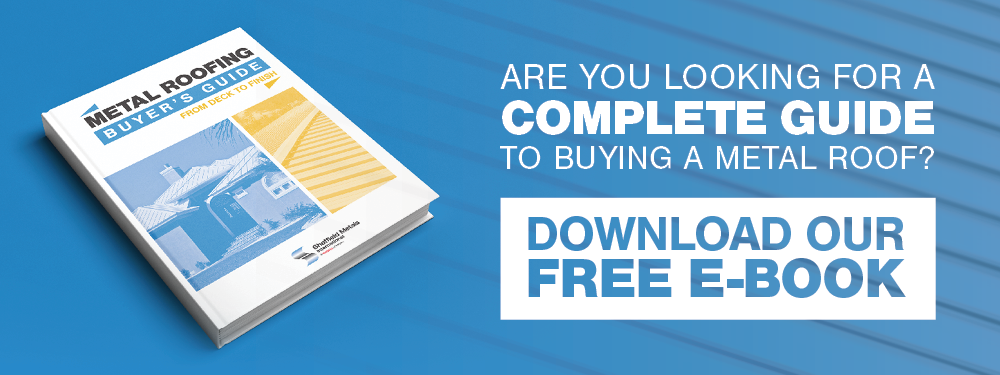If you’re going through the process of choosing the right metal roof material for your project, you’ll see that two of the most common choices are steel (Galvalume®) and aluminum.
Both are great options for standing seam metal roofing projects, but there are some situations when Galvalume is the better choice and some when aluminum will work best.
Sheffield Metals is a leading metal sheet and coil distributor — in both Galvalume and aluminum substrate options — for the architecturally-driven metal roof and wall industry. We’ve helped hundreds of home and property owners, contractors, architects, and manufacturers choose the right metal for their project(s).
That’s why we believe comparing Galvalume vs. aluminum and the pros and cons of using each material is important.
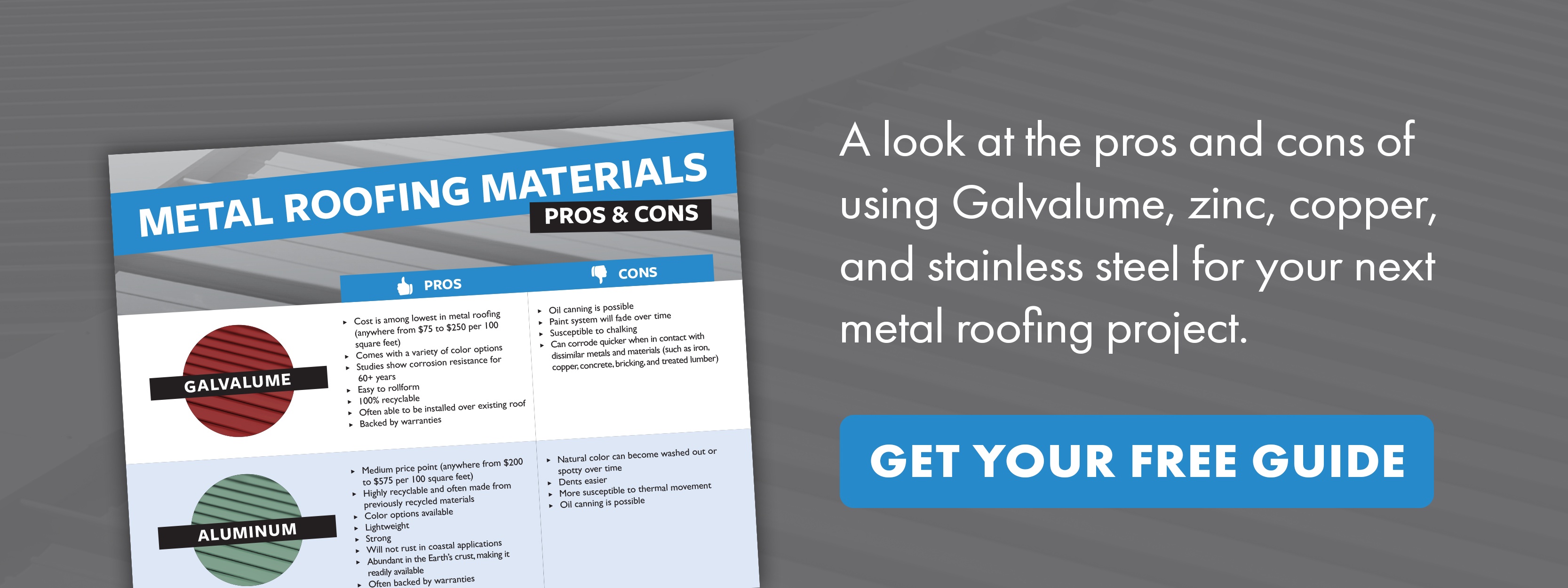
Galvalume® Steel Metal Roofing: Uses, Pros, & Cons
Galvalume, a flat rolled steel-based metal roofing material, combines three of the most high-performing metallic coatings used in roofing today — steel, aluminum, and zinc. To create Galvalume, mills begin with a cold-rolled carbon steel base sheet that is then continuously hot-dipped with aluminum and zinc alloys (AZ) until it reaches a coating of 55% aluminum, 43.4% zinc, and 1.6% silicone. This process allows Galvalume to have some of the best characteristics of each metal, which is why it’s one of the most popular metals used in metal roofing.
Galvalume can be utilized as a roof, wall, trim, accent, and more in most building applications. Plus, it’s suitable for use in some extreme environments, such as non-coastal hurricane zones, high rain or snowfall locations, high-temperature regions, and more.
Here’s a selection of some of the most common applications that use Galvalume:
- Architectural projects – Many applications, including commercial, residential, etc.
- Commercial buildings – Schools, hotels, manufacturing, retail stores, etc.
- Residential projects – Single and multi-family homes, condominiums, apartments, etc.
- Structural or industrial applications – Warehouses, factories, storage, etc.
- Agricultural structures – Non-animal confinement buildings, barns, etc.
- Miscellaneous – Accent roofs, pavilions, mailboxes, solar trays, pre-fabricated flashings, etc.
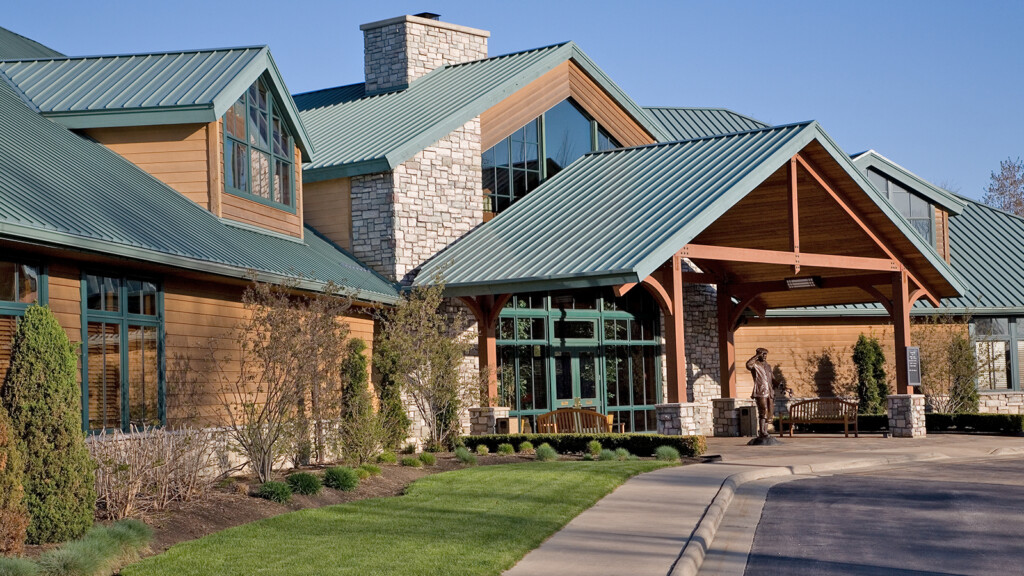
In standing seam metal roofing, the most common thickness of Galvalume is 24-gauge, but anywhere from 22 to 29-gauge material is standard. Galvalume is sometimes referred to by its coating weights, AZ-50 and AZ-55. Here’s a breakdown of these two terms:
- AZ-50: 0.50 ounces per square foot combined (both sides) of the aluminum-zinc alloy coating applied to both sides of the substrate. AZ-50 is the typical coating weight for painted sheet and coil products.
- AZ-55: 0.55 ounces per square foot of the aluminum-zinc alloy coating applied to both sides of the substrate (combined). AZ-55 is the typical coating weight for bare or unpainted sheet and coil products — called acrylic-coated Galvalume or Galvalume Plus.
- Remember that AZ-55 Galvalume has a slightly heavier coating weight and includes a light acrylic coating protecting the material. However, this acrylic coating will wear off over time with exposure and requires special care during shipping, handling, and installation to avoid scuffing/perforating the coating.
Advantages & Pros of Galvalume® Metal Roofing
Warrantied product – One of the main selling points of Galvalume is the 25.5-year warranty on the substrate, which is sometimes referred to as a perforation warranty. Galvalume systems also often come with paint warranties that further protect your investment and provide peace of mind that the roof or wall system will last. Plus, non-residential property owners can buy a weathertight warranty for their Galvalume roofing structure, which ensures the roof was installed correctly and adheres to strict installation details. (Note: Substrate or paint warranties are NOT available for Galvalume products within 1,500 feet of a coast.)
Corrosion resistance & self-healing properties – Galvalume’s coating formula combines zinc’s strength and self-healing characteristics with the rust-resisting properties of aluminum. These characteristics help control the red rusting at exposed edges of Galvalume panels. Most steel-based products will experience typical edge creep from the exposed steel, but it will eventually stop with Galvalume. These characteristics make failure in the roof field less likely with Galvalume systems.
Easy to handle & install – Another benefit of Galvalume is that it’s not as temperamental as other metals used in the roofing industry. Installers don’t have to worry as much about leaving fingerprints, dents, deep scratches, etc., on Galvalume panels because they’re tougher and more tolerable. It also doesn’t have many strict ventilation or air gap requirements like some other metals — including aluminum. Galvalume is a standard metal roofing product and often doesn’t have special installation details or requirements.
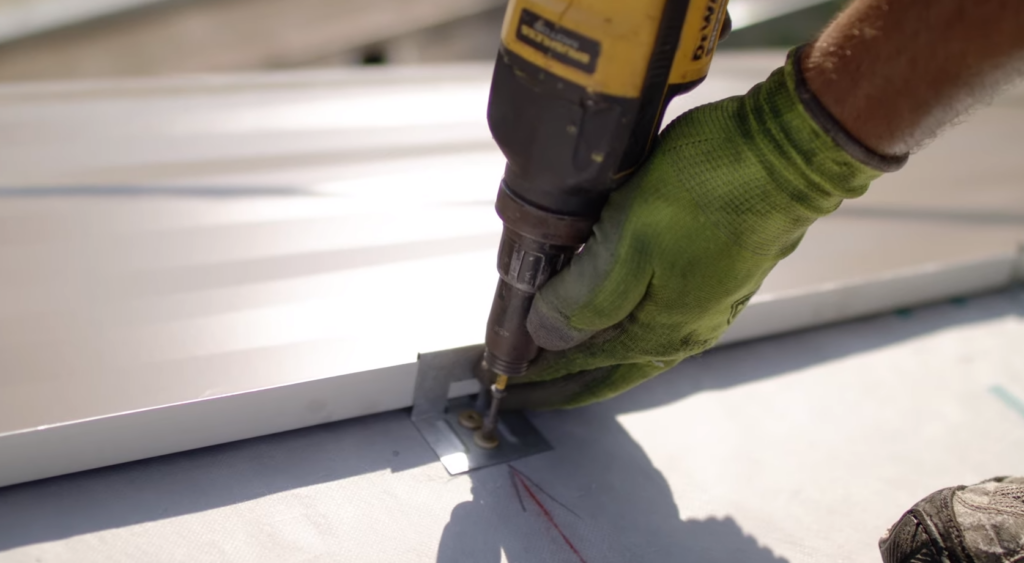
Economical & competitively priced – For the most part, Galvalume is reasonably priced and one of the most affordable metal materials available for roofing products — especially when compared to aluminum. Here are average price ranges for just Galvalume coil; these numbers do NOT account for installation, other thicknesses, rollforming, finishes, colors, locations, or special orders:
- Bare Galvalume (acrylic-coated): $1.25 to $1.85 per square foot
- Painted Galvalume: $1.75 to $2.35 per square foot
Keep in mind that into mid-2022, steel prices are continually fluctuating, so the price can vary dramatically.
Disadvantages & Cons of Galvalume® Metal Roofing
Not recommended in coastal environments – The coating of Galvalume will not stand up to the conditions associated with a coastal environment, including properties up against breaking surfs, large bays, marshes, and other coastlines. Specifically, saltwater will degrade the Galvalume coating and lead to premature damage to the roof or wall. It’s recommended that properties within a certain distance of a coast use an engineered aluminum roof system, as aluminum resists corrosion and rusting from saltwater for much longer.
Not suitable for most animal enclosures/buildings – Galvalume is not suitable for use on buildings where animals are housed or held. Animal waste products put off ammonia gas, which over time reacts with the Galvalume coating and leads to degradation of the metal. However, Galvalume is sometimes used on modern chicken houses with a vapor barrier between the chicken area and the roof for appropriate ventilation. It’s best to check with the manufacturer before putting Galvalume on any animal confinement building, as it’s often dependent on the structure’s use and design.
Heavier than aluminum – When looking at the weight of a roofing product, there are pros (durability, ease of installation, etc.) and cons (stress on the building structure, etc.) to heavier materials. Overall, metal roofing is significantly lighter than asphalt shingles, tiles, and most other roofing materials. When compared to Galvalume, aluminum is more lightweight. A typical 24-gauge Galvalume roof weighs anywhere from 1 to 1.5 pounds per square foot for a finished panel, and a .032 aluminum roof weighs less than half of that same 24-gauge Galvalume panel.
Interactions with other materials – Galvalume performs best when not in contact with specific building materials, including concrete, treated lumber, copper, lead, bricks, and iron. If Galvalume is in contact with one of these and is then introduced to an electrolyte such as water, it can lead to galvanic corrosion of the metal and potential failure of the roof system.
Also, if you are using multiple types of building products, be sure to confirm with manufacturers that their products are compatible. For instance, let’s say you want a metal roof with wood shingles. Some wood shingles are “treated,” and often times the treatment can react adversely with the metal roof.
Aluminum Metal Roofing: Uses, Pros, & Cons
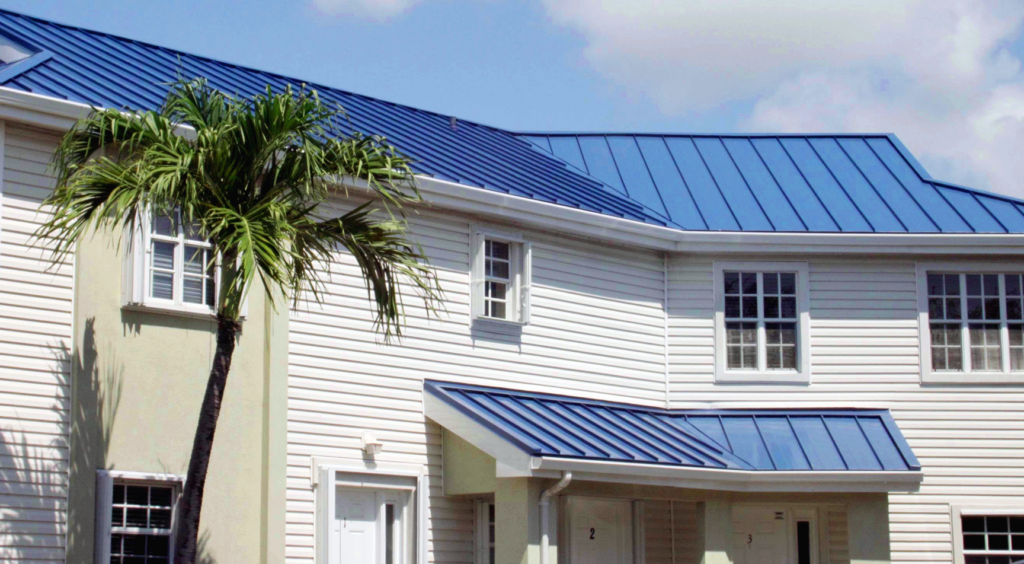
Aluminum is a lightweight, silver-white metal that is element 13 on the periodic table and is the third most abundant element on Earth. However, aluminum never occurs in its metallic form in nature. Its compounds, usually aluminum sulfates, are chemically broken down using electrolysis/electrolytic reduction to produce the aluminum metal material.
Aluminum sheet and coil products used to make panels are sold according to the thickness in inches (usually in decimal form), so the higher the number/decimal, the thicker the aluminum material. There are varying thicknesses of aluminum, but the size to purchase is often dependent on the use or application:
- For commercial roofing projects: .037”-.044” is the most common
- For residential roofing projects: 027”-.034” is the most common
- Copings or caps: .050” or .063” are the most common
- Note: If a project requires engineering, make sure the thickness of the material used is (at minimum) the thickness tested. Like steel, a range of acceptable tolerances make up .032”/.040, etc.
Plus, aluminum typically comes in similar (if not the same) color, finish, and paint system options as Galvalume.
Overall, aluminum is suitable as a roof, wall, trim, and more in several different environments, including coastal environments, hurricane zones, locations with high rain or snowfall, high-temperature regions, and more. Here are some ordinary aluminum roofing applications:
- Coastal structures – Hotels, resorts, condominiums, homes, boathouses, etc.
- Commercial buildings – Hospitals, schools, stores, government buildings, etc.
- Residential projects – Single-family, multi-family, condos, etc.
- Architectural structures – Commercial, governmental, residential, etc.
- Structural or industrial applications – Warehouses, factories, etc.
Benefits of Aluminum Metal Roofing
Self-healing & no red rust – Aluminum is unique in how it handles the minimal corrosion it experiences. When it begins to corrode, it doesn’t red rust as steel products do; instead, it oxides and forms hard oxidation (or oxide film) on its coating, which protects the metal. This helps to preserve the material and make it last in corrosive environments, like coastlines. Plus, the oxidation forms rather quickly, so there’s no edge creep or red-rust formation that can happen with steel material.
Suitable for use in coastal environments – One of aluminum’s most significant selling points is that it performs well in coastal environments. As we mentioned, aluminum has much better corrosion resistance than steel products, especially in harsh coastal environments where saltwater can wreak havoc on a roof system. Because aluminum oxidizes as it starts to corrode, it makes it stronger and prolongs the system’s life on the coast. This makes aluminum the metal roofing material most commonly installed in the Caribbean Islands, on the Atlantic coastline, the Gulf Coast, and the Pacific Coast. Best of all, aluminum roofing systems still carry a PVDF paint warranty when installed in coastal areas.
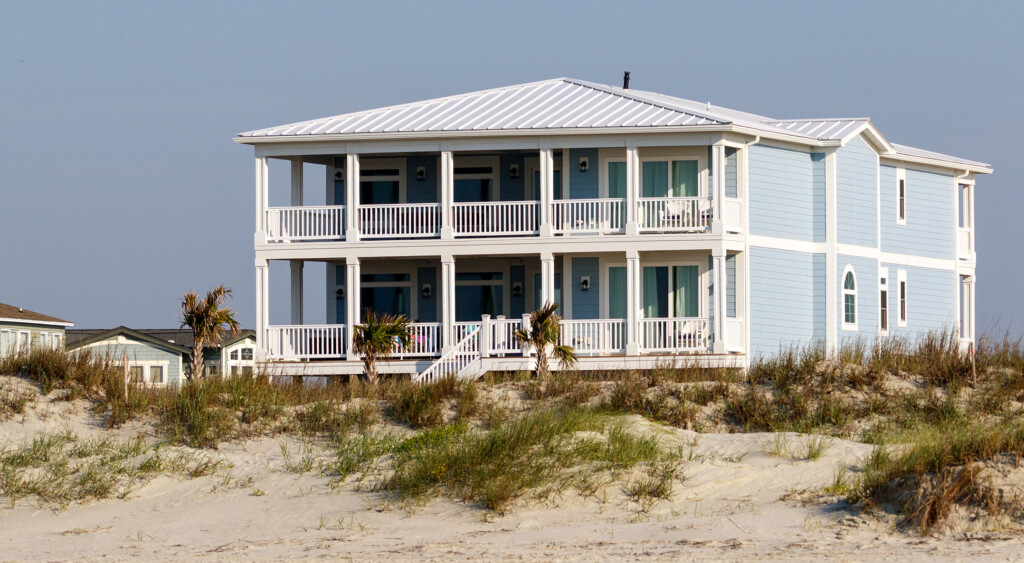
Warrantied product – Aluminum metal roofs come with various warranty options, including paint, substrate, and weathertight warranties, which help protect your investment and provide peace of mind that the roof or wall system will last. There are even paint warranties available on aluminum products used in coastal applications. For example, Sheffield Metals offers a 25-year PVDF paint warranty for coastal properties and a 20-year PVDF paint warranty for Caribbean properties. Or, if your property is NOT in a coastal environment, our standard 40-year PVDF warranty applies to aluminum roofs as well.
Suppose you’re a commercial property owner and your building is on a coast. In that case, you even have the option to buy a weathertight warranty for an aluminum roofing structure, which ensures the roof was installed correctly and adheres to strict installation details. Learn more about Sheffield Metals’ weathertight warranties in this comprehensive article.
Lightweight – As we discussed, metal roofing is one of the lighter roofing materials, which helps reduce the added stress on a building’s frame. Aluminum is one of the most lightweight metal materials, which makes it easier for contractors to transport, handle, and get panels onto the building. Plus, if you’re running panels on-site with a portable rollforming machine, a lighter coil can be easier to transport and puts less stress on the rollformer. (Note: Because .032” aluminum is thicker than 24-gauge Galvalume, aluminum coils will be slightly less lineal footage).
Highly recyclable – Metal is almost always recyclable in one way or another, and aluminum is one of the world’s most reusable and sustainable metals. About 95% of all aluminum roofing systems installed worldwide are made from previously recycled aluminum materials. At Sheffield Metals, we use a 3000 series aluminum alloy (3105) primarily made from previously recycled materials and very little pure aluminum. Aluminum’s high recyclability and reusability are why many people choose aluminum for their projects, especially those looking to meet LEED certification requirements.
Thicker materials available vs. steel – Thicker aluminum is more readily available than steel, which is a distinct advantage for larger copings. Galvalume is typically readily available in thicknesses up to 22-gauge (approximately .030”), and aluminum is generally available in thicknesses of .050″ and .063″, depending on the metal supplier. This allows contractors to have larger copings and fascias while minimizing the appearance of oil canning.
Drawbacks of Aluminum Metal Roofing
Easier to bend and dent – This drawback is both a benefit and a disadvantage of aluminum. On the one hand, aluminum is more malleable than steel, which means it can be easily bent and fabricated without experiencing any breaks or cracks. This is especially helpful during the rollforming and fabrication of panels. However, since aluminum is a little softer and lighter, it has been known to dent easier than other metals during and after the installation. Contractors should use extra caution when handling, removing PVC, and installing aluminum panels. Improper handling can cause imperfections and/or oil canning to be visible in the finished installed panel. Additionally, if a structure is beneath trees or other objects that could fall on the roof, another type of metal material may be a better option to help preserve the roof’s look.
Luckily, the tensile strength of aluminum is comparable to steel, but aluminum is more susceptible to surface denting.
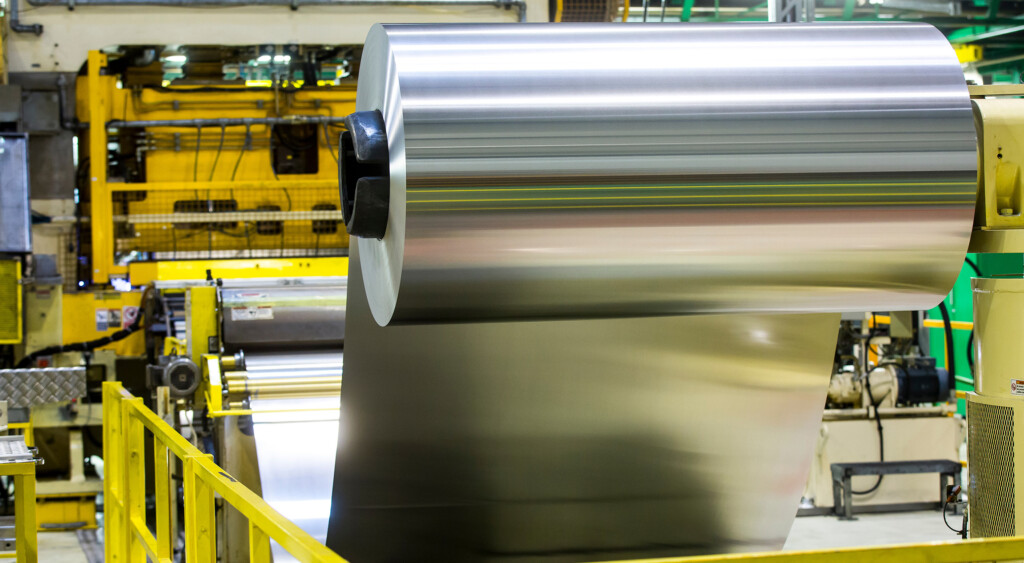
Medium to high price point – Aluminum is in the mid to high price range for material cost, which makes it not the most affordable metal material option. On average, aluminum sheets and coil (not accounting for rollforming, installation, finishes, color, location, etc.) comes in at about $2.20 to $3.00 per square foot. Similar to Galvalume, aluminum is also experiencing price fluctuations in 2022.
Requires more space for thermal movement – Aluminum expands and contracts roughly twice as much as a steel roof. This is something that contractors need to be aware of during the installation to allow enough room for the thermal movement of the panels. This is especially important when using a mechanically seamed profile in panel lengths greater than 15-20 feet. It’s recommended that an expansion clip be used per the applicable engineering for panels of a longer length. Restricted expansion and contraction of an aluminum roof can cause oil canning, increased noise, and more required maintenance on any exposed fasteners.
Natural color – It’s typically not recommended to use a bare aluminum product with its natural silver-gray color. As the metal ages, experiences weathering, and oxidizes (white rust), it doesn’t hold its original mill-finished color and often becomes washed out and spotty. The best way to overcome this issue is to buy painted roofing coils or panels, which will age much cleaner over time because the paint covers any metal color changes.
Galvalume (Steel) vs. Aluminum – Which Should You Choose?
To help with the decision process, we wanted to lay out some common scenarios that might influence the material you choose for your project.
Scenario #1: Your home or building is in a coastal environment.
Best material choice: Aluminum
Explanation: Galvalume/steel materials will corrode when exposed to saltwater environments and lead to the premature failure of your roof. On the other hand, as aluminum is exposed to saltwater/coastal conditions, the material begins to oxidize, making it stronger and prolonging the system’s life. You will undoubtedly want to choose an aluminum metal roofing system for coastal properties. You then qualify for more warranty options, including paint and weathertight warranties.
Scenario #2: Your home or building is in a standard, non-corrosive environment.
Best material choice: Galvalume or aluminum, but usually Galvalume
Explanation: For the most part, homes and properties that are not on the coast will end up choosing a Galvalume metal roofing system. It’s more common/readily available, has standard installation details, and is the more economical choice. However, aluminum is still an option for non-coastal projects as well.
Scenario #3: You want a bare metal finish.
Best material choice: Galvalume
Explanation: Acrylic-coated Galvalume (AZ-55 or Galvalume Plus) is an excellent option for those looking for a natural bare metal finish. Bare aluminum is usually not a color or material option, as the metal will become washed out and spotty over time. Galvalume and aluminum can also be coated in paint systems similar to bare metal colors/finishes, such as Silver Metallic, Copper Metallic, and Medium Bronze.
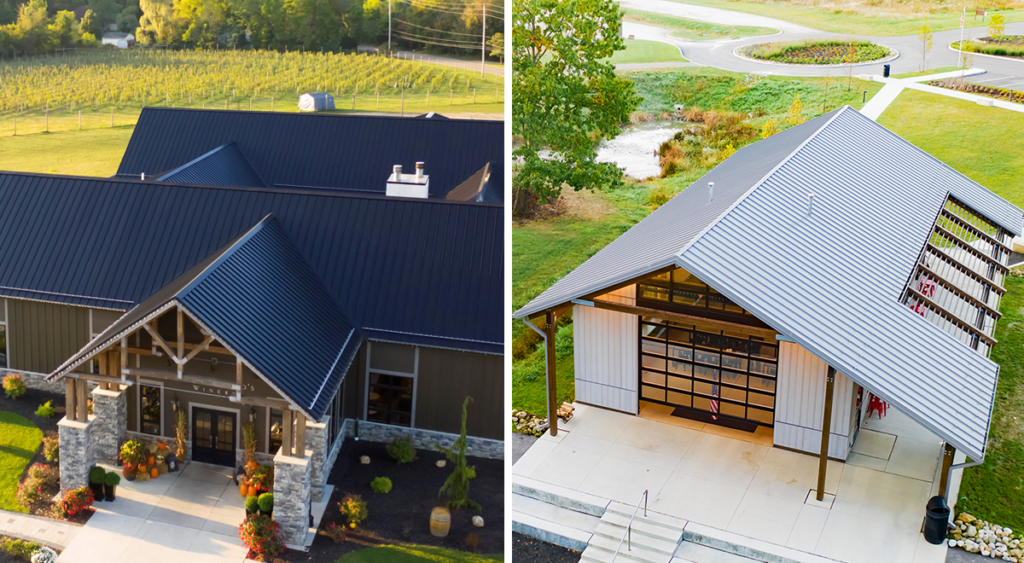
Scenario #4: You want a warrantied roofing product
Best material choice: Both Galvalume and aluminum
Explanation: As we discussed, Galvalume and aluminum have various warranty options, including paint and weathertight. The level of coverage will vary based on your location, paint system, panel profile, etc. However, there are still warranty options available for Galvalume and aluminum products installed according to the manufacturer’s warranty requirements.
Scenario #5: You’re concerned about oil canning.
Best material choice: Neither (or choose a striation or rib-roller for the flat of the panel)
Explanation: Oil canning is an inherent characteristic of light-gauge, cold-formed metal products — including Galvalume and aluminum. It is a visual phenomenon seen as waviness or distortion in the flat surfaces of metal panels. Luckily, oil canning is only an aesthetic concern that does not affect the strength or performance of the system.
Plus, there are methods to minimize the appearance of oil canning, including:
- Purchasing a thicker sheet or coil product.
- Buying trustworthy brands of coils and sheets.
- Rollforming panels with striations or bead stiffeners in the flat area of panels.
- Hiring an experienced contractor who knows the best material handling and installation practices that help reduce oil canning.
- Ensuring there are no roof decking issues, as the metal will follow any inconsistencies on the deck.
Final Thoughts on Galvalume vs. Aluminum Metal Roofing
So, is Galvalume or aluminum the better material? It depends.
When choosing between materials for your project, a qualified, skilled, and knowledgeable contractor or manufacturer is the best place to start. They will be able to recommend the material that is best based on your project attributes, which may include (but is not limited to):
- The location, specifically your proximity to a coastline
- Your budget
- Your warranty expectations
- The finish you want (bare vs. painted)
- Recyclability/green requirements
- Other building elements
Sheffield Metals is dedicated to educating customers and potential buyers to make the most informed decision about the best metal material for their roofing project — Galvalume, aluminum, or otherwise. Whether you’re a contractor, architect, manufacturer, property owner, or beyond, we can work with you to choose the right product.
Contact one of our knowledgeable metal roofing specialists today to ask your questions about Galvalume, aluminum, or any other metal roof type!
